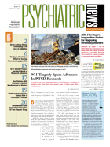Impulsivity has been strongly linked to problematic behaviors and a spate of psychiatric disorders.
But what is the neurobiological basis of this personality trait?
Past research implicated the neurotransmitters serotonin and dopamine in the prefrontal cortex and striatum regions of the brain. Now a new study conducted by United Kingdom and U.S. scientists implicates the neurotransmitter GABA in the prefrontal cortex as well.
The lead scientist was Frederic Boy, Ph.D., a Wellcome Trust research associate at Cardiff University in Wales. The findings were published July 15 in Biological Psychiatry.
As Boy explained to Psychiatric News, his research colleagues refined the magnetic resonance spectroscopy (MRS) method so that it could measure GABA levels in the brain. They then used MRS to measure concentrations of GABA in the brains of 25 healthy men.
After that, the scientists evaluated the subjects for the trait of impulsivity and looked to see whether levels of GABA in the subjects' brains were related to the degree of impulsivity they displayed.
They found that impulsivity was related to the concentration of GABA in the dorsolateral prefrontal cortex, but not in any other brain areas they examined. The less GABA present in the dorsolateral prefrontal cortex, the more impulsive a subject was.
"These findings," they concluded, "help account for individual differences in self-control and thus clarify the relationship between GABA and a wide range of psychiatric disorders associated with impaired self-control."
And while the findings do not have direct clinical implications, "knowing what GABA in the dorsolateral prefrontal cortex does can further our understanding of the role of motivations or the processing of reward information (in alcohol/substance abuse, for instance)," Boy said. "[Indeed,] strong neural connections between the dorsolateral prefrontal cortex and midbrain structures responsible for the processing of reward have been documented."
"This study was technically novel because it used a noninvasive brain imaging technique, MRS, to measure brain GABA levels," John Krystal, M.D., chair of psychiatry at Yale University and editor of Biological Psychiatry, told Psychiatric News. "GABA levels are low relative to other brain chemicals that potentially confound its measurement. Measuring GABA levels in the brain with spectroscopy is a bit like measuring the number of shirts in a pile of laundry. Thus, the ability to reliably measure GABA levels in the frontal cortex, as Dr. Boy and his colleagues have done, is a technical achievement."
"By helping us explore the neurochemical bases of poor impulse control," Krystal continued, "Dr. Boy and his colleagues provide new insights into both the brain circuits and the brain chemicals that may contribute to this trait, which is often maladaptive."
Yet just because the researchers found that the less GABA there was in the dorsolateral prefrontal cortex, the more impulsive a subject was does not mean that "subjects in this study were impulsive because their brains were not inhibited," Krystal stressed. "GABA is the primary inhibitory neurotransmitter in the brain... [but] GABA is [also] responsible for tuning the activity of brain circuits. Thus the low GABA levels... may contribute to [impulsivity] by influencing the capacity of the dorsolateral prefrontal cortex to optimize the function of brain circuits involved in emotion, motivation, or response inhibition."
The study was funded by the Wellcome Trust and the Wales Institute of Cognitive Neuroscience.
